In the course of running a blog or owning a business, there is probably going to come a time when putting on a webinar is necessary. This could be for any number of reasons: teaching a course, training employees, running a workshop, conducting an online panel discussion, hosting distributed events, or any other reason you might be able to think of.
In today’s post we’re going to go over the best software currently available for making all of those things possible.
The 15 Best Webinar Software Available
To be clear, in case anyone is unfamiliar with the term webinar, they are nothing more than an online conference or meeting–in whatever flavor you may choose.
The list of software options below will all help you conduct meetings of various types. Some are better for certain use cases than others, but the list as a whole is not in any sort of ranking order; such as best to worst or anything like that.
Basically, if it made the list it is worth checking out. Only you will know if one solution suites your personal needs better than the others. That said, I have a brief note below that is also worth checking out in light of all the reviews I read while researching this post.
1. Google+ Hangouts
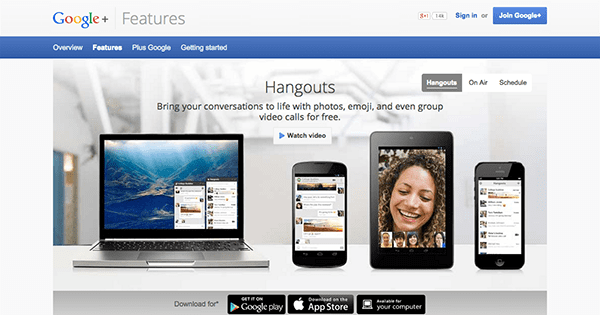
Google+ Hangout is the breakout video calling/chat feature of the Google+ social platform. It’s been baked into Google Chat, Gmail, and the standard Google+ Profile. All you need to use it is have a free Google+ account.
While not your standard premium webinar platform, it comes with a remarkable number of features for collaborative meetings, presentations, workshops, etc. About the only thing it doesn’t do (yet) is allow you to charge your audience to hangout or sell within a hangout.
Key Features:
- Up to 10 people in a single video/audio call.
- Ability to live stream straight to your attached YouTube Channel and/or a website. All while live at the hangout link too.
- Can automatically record and publish hangouts to YouTube.
- Works on all devices and platforms.
- Send photos, emoji, and chat messages during hangout.
- Screen share
Price: FREE
2. Webinars OnAir
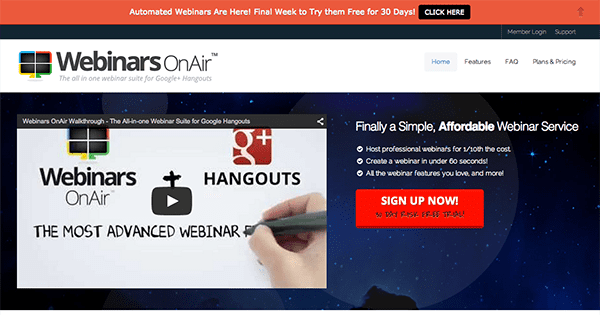
This product is actually built on top of Google+ Hangouts. As I mentioned above, you cannot sell a webinar on Google+ Hangouts or products within a hangout. This platform allows you to do that and more while maintaining the ease of use that made Hangouts popular in the first place.
Key Features:
- Charge Attendees to Join
- Sell your stuff with one click
- Custom post redirection after registration
- Email autoresponder integration
- Attendee tracking
Price: starts at $25/month for up to 25 webinar attendees
3. Skype

Skype is one of the world’s most popular calling and video conferencing apps already. Which is why many choose to use it for group meetings, coaching, workshopping, etc.
Key Features:
- Skype to Skype calls
- Group Voice Calls (up to 25 people)
- Group Video Calls
- File Sharing
- Screen Sharing
- Group Screen Sharing
- Contact Sending
Price: FREE
4. GoToWebinar

GoToWebinar is by the folks at GoToMeeting, the popular meeting and screen sharing application/service. The webinar version is, as you can probably guess, catered specifically to the needs of people putting webinars on as products/services in and of themselves.
Key Features:
- Full Services Attendee Registration
- HD Video Recording
- Archived Recordings
- Polls & Surveys
Price: Starts at $79/month per organizer with up to 100 attendees
5. Cisco WebEx
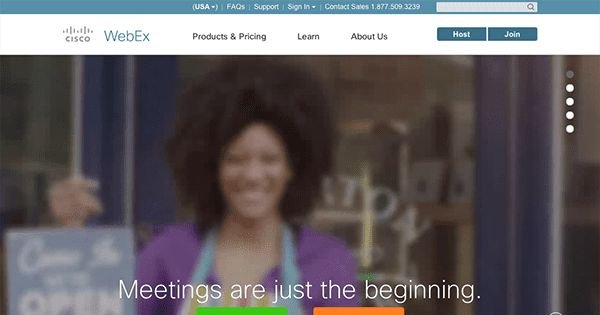
Cisco WebEx is part of a whole family of Cisco products for remote collaborative work. Specifically, their Event Center product is used for putting on events and webinars.
This is one of a handful of higher end options–including GoToWebinar above and a few more–that scale well but are not for those with a tight budget. That said, you get a lot of great features for what you pay for.
Key Features:
- Branded Registration and Invites
- Registration tracking
- Lead generation tools
- Display 5 panelists at a time plus slides/data
- Polls
- Chat
- Hight Quality Video/Audio
- Professional Webinar Planning & Production (add-ons)
Price: starts at $79/month (billed annually) with up to 100 attendees
6. Adobe Connect
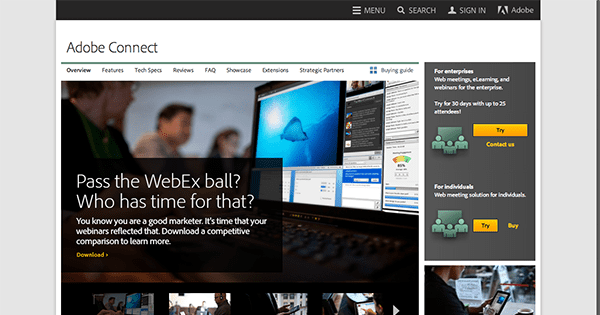
Most of you are familiar with Adobe’s Creative Suite of products, but through their product Adobe Connect they also empower organizations to put on impressive webinars and events.
Key Features:
- Complete mobile collaboration
- Rich multimedia options
- High-quality audio/video
- Video conferencing integration
- Real-time collaboration with presenters
- Invitation and privilege management
- Breakout rooms to focus discussion
- Broad set of collaboration capabilities
- Streaming video integration
- Microsoft Outlook integration
- Analytics and tracking
- Recording
- Archiving
- And more
Price: starts at $45/month per host with up to 25 attendees
7. MegaMeeting
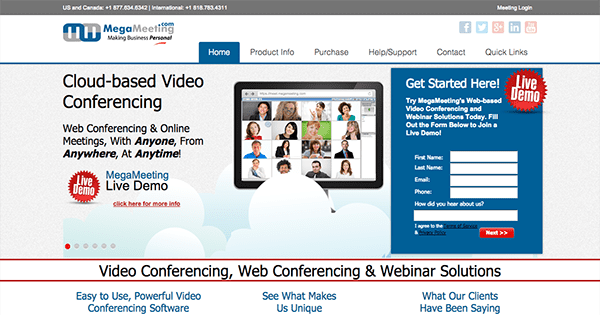
MegaMeeting is for online training, seminars, product demonstrations, and more. It’s 100% browser based and mobile ready to make collaboration easy.
Key Features:
- Video streaming
- Multiple ways to join a meeting
- Secure conferencing
- Text Chat
- Works across multiple platforms (Mac/Pc)
- Share powerpoints, docs & websites
- Screen sharing
- Polls & Surveys
- PayPal integration
- Multiple meeting rooms
Price: starting at $39/month (no stated attendee limit)
8. ReadyTalk
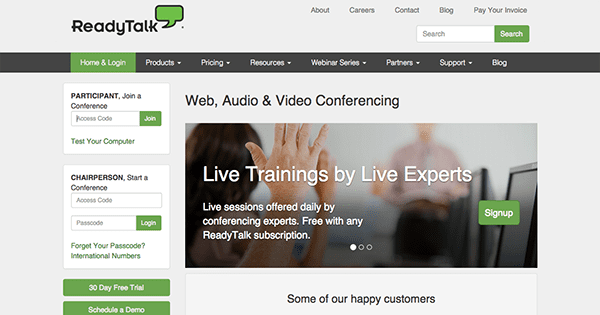
ReadyTalk has a suite of products for everything from web conferencing, to audio conferencing, video conferencing, mobile conferencing, webinars and events, recordings and archiving.
Key Features:
- Customized branding
- “Add to Calendar” invitation links for Outlook and Google
- Customized registration forms
- Flexible confirmation options
- One-click recording
- Chat/Q&A sessions
- Sharing options
- Social promotion tools
- Polling
- Follow-up emails
- Archive hosting and distribution
- And more
Price: starting at $49/month with up to 25 attendees
9. AnyMeeting
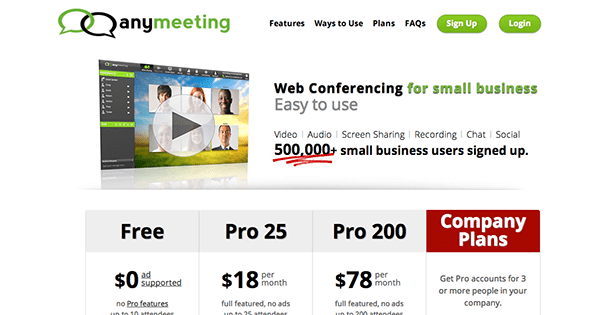
AnyMeeting is aimed at providing a solid web conferencing solution to small businesses.
Key Features:
- Hold large or small meetings
- Share your screen
- 6-way video conferencing
- Custom meeting branding
- Recording
- Phone support
- Play YouTube videos
- Built-in conference calling
- Present powerpoint slides
- Mobile friendly
- Facebook and Twitter integration
- Personalized meeting url
Price: FREE up to 10 attendees (ad supported). $18/month for 25 attendees.
10. OnStream
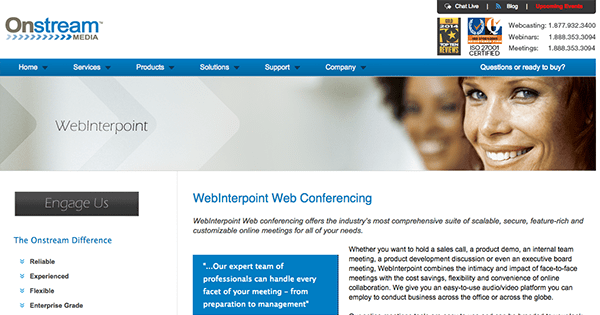
OnStream Media has a number of cloud based solutions for media hosting, webcasting, and webinars. Their specific webinar product is enterprise grade, meaning it’s meant to scale dramatically.
Key Features:
- Event management
- Messaging and chat
- Live audio and video streaming
- Screen sharing
- File sharing
- Participant list and rights management
- Recording and archiving
- Real-time polling
Price: Per usage. No minimums. Must call for quotes.
11. ClickWebinar

ClickWebinar is by the same folks who created ClickMeeting. ClickWebinar aims to be a high end (but at a low(er) price) solution for anyone needing to collaborate remotely for events and webinars.
Key Features:
- Global web conferencing
- Webinar rebranding
- Full desktop and browser sharing
- Moderation tools
- Simultaneous chat translation
- ClickMeeting API
- Integration with the following tools/services
- Microsoft Office
- Adobe
- Google Calendar
- YouTube
- Flickr
- iCal
- And more
Price: Free 30 day trial. Plans start at $30/month with up to 25 attendees
12. omNovia
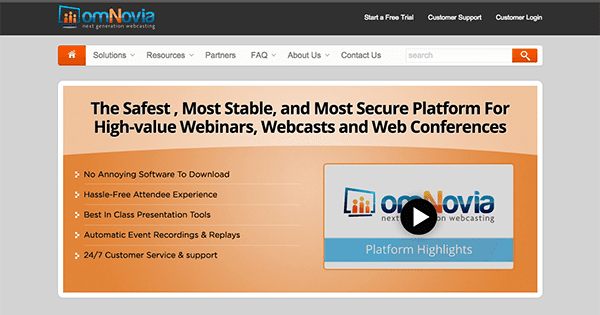
omNovia is a powerful presentation platform for creating high quality online events. This includes webinars, webcasting, services (such as coaching or training), and more.
Key Features:
- Slide show presentations
- Instant polling
- Event registration
- Recording
- Fully customizable interface
- Credit card integration
- Chat and Q&A
- Twitter integration
- Cobrowser (take control of user screens with permission)
- Documents sharing
Price: Free trial. Pricing plans upon request.
13. iLinc
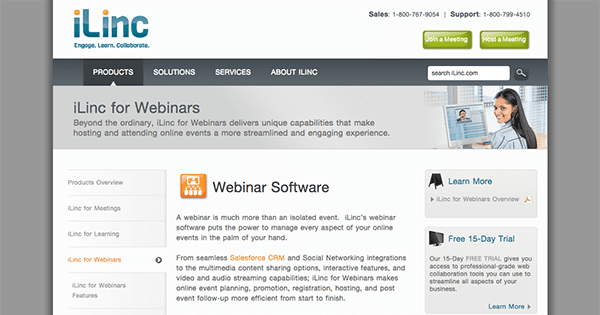
iLinc is a company that does nothing but deliver web conferencing and collaboration services. Their goal is to design their tools to take the friction out of mobile/distributed collaboration.
Key Features:
- Host events with up to 1,000 people
- Send Invites
- Set up registration forms
- Send follow-up emails
- Promote events via social media
- Monitor attendee engagement
Price: Free trial. Pricing plans upon request.
14. Blackboard Collaborate
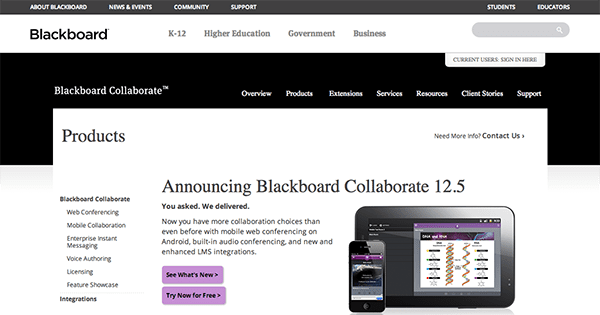
Blackboard Collaborate is a webinar software designed with a focus on education. They have specific services and resources for K-12, Higher Education, Government, and Business.
Key Features:
- Web conferencing
- Voice authoring
- Mobile collaboration
- LMS integration
- Enterprise instant messaging
- Licensing
- And more
Price: Free trial. Pricing plans upon request.
15. Brainshark
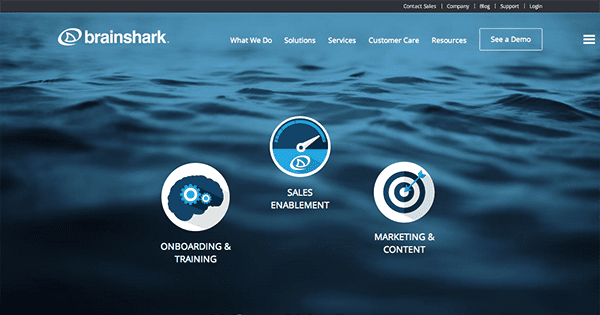
Brainshark is a web conferencing service aimed at helping companies train their sales staffs more effectively through onboarding training, sales enablement, and marketing & content.
Key Features:
- Rapid content creation
- Controlled Access
- Detailed Analytics
- Conversion stories
- And more
Price: Pricing upon request.
A Note on Quality & Finding the Right Fit
I have a confession to make. When I made the title of this post “The Best Webinar Software Available” I may have misled some of you to believe that there is such a thing as really great all-purpose webinar software to begin with.
According to my personal experience and the wider range of experiences I’ve read about via reviews and similar posts–that doesn’t exist.
The general consensus of all the posts, comments, and reviews I read was that GoToWebinar is the most reliable choice–but it’s also clunky, ugly, and not that fun to use.
Others hold lots of promise in terms of design, usability, etc. but fail to meet expectations in a few key places: reliability, scalability, cost, and flexibility. But of course not necessarily all at once or to the same degree across the board.
What I mean when I say “reliable” should be pretty straight forward. They simply don’t work reliably. They might work great during a practice run, then bug out and wreck a live presentation.
Scalability and cost are often linked. Many of these services are capable of reaching large groups of people with all of the features a user may want–but they’re too expensive at that level.
And finally, flexibility is an issue for many of these programs because of the nature of the problem they’re trying to solve.
You may have noticed that at the top of this post I mentioned a handful of reasons someone might want to put on a webinar–which means many of these programs are designed for specific niches or are trying to be too many things at once.
It’s a tough nut to crack, I’m sure. I’m not an enterprise software developer so I don’t know all of the inherent problems they face when attempting to create this type of software, but it doesn’t seem like anyone has created that breakthrough product in this field yet.
At least not that I could find.
So please, if you have, tell us about it in the comments section.
So What’s My Conclusion?
For those of us who are actively doing webinars right now or have plans to do them in the future, some of us will have to choose a platform based solely on features. Whether or not we like the design, usability, or cost.
This is because when it comes right down to it, we have to make money via our efforts and whether that means charging for attendee spots, selling products during a webinar, or improving the sales of our business through effective training–we may not get the perfect package.
Personally, as a content producer and storytelling consultant, I use Google+ Hangouts for all of my webinar needs. I’m able to privately collaborate with small teams on stories and/or strategy. I can run small workshops with up to 10 people at once. Or I can broadcast conversations/interviews to my website and YouTube channel.
Over the last year or so I’ve mostly done collaboration and consulting, but in 2016 I hope to make the broadcast features of Google+ Hangouts a bigger part of what I do–so maybe I can write about that experience again in the future.
I also hope to optimize my consulting sales process and workflow by using booking plugins on my website to book specific Hangout times throughout my week. That way I can spend less time emailing back and forth with prospects and essentially just show up for paid time where we can all be most productive.
But that’s just my personal solution. I know a lot of people who do something similar, but still more where this sort of small solution just doesn’t meet all of their needs.
What is your webinar solution? Do you have a software you’d recommend? Did seeing any in the list above make you want to try something new?
Please take a few moments to share your thoughts and experiences with the community in the comments below.



Would love to here from you...